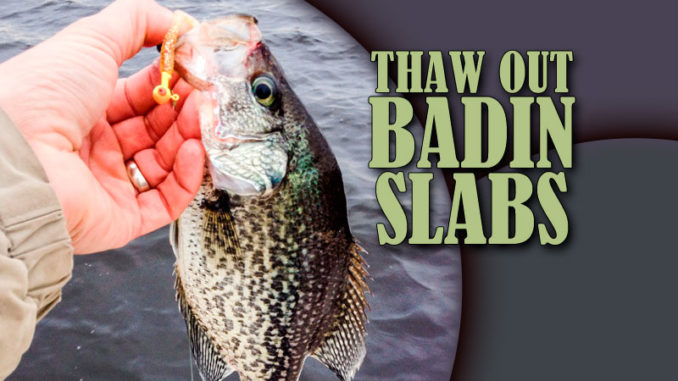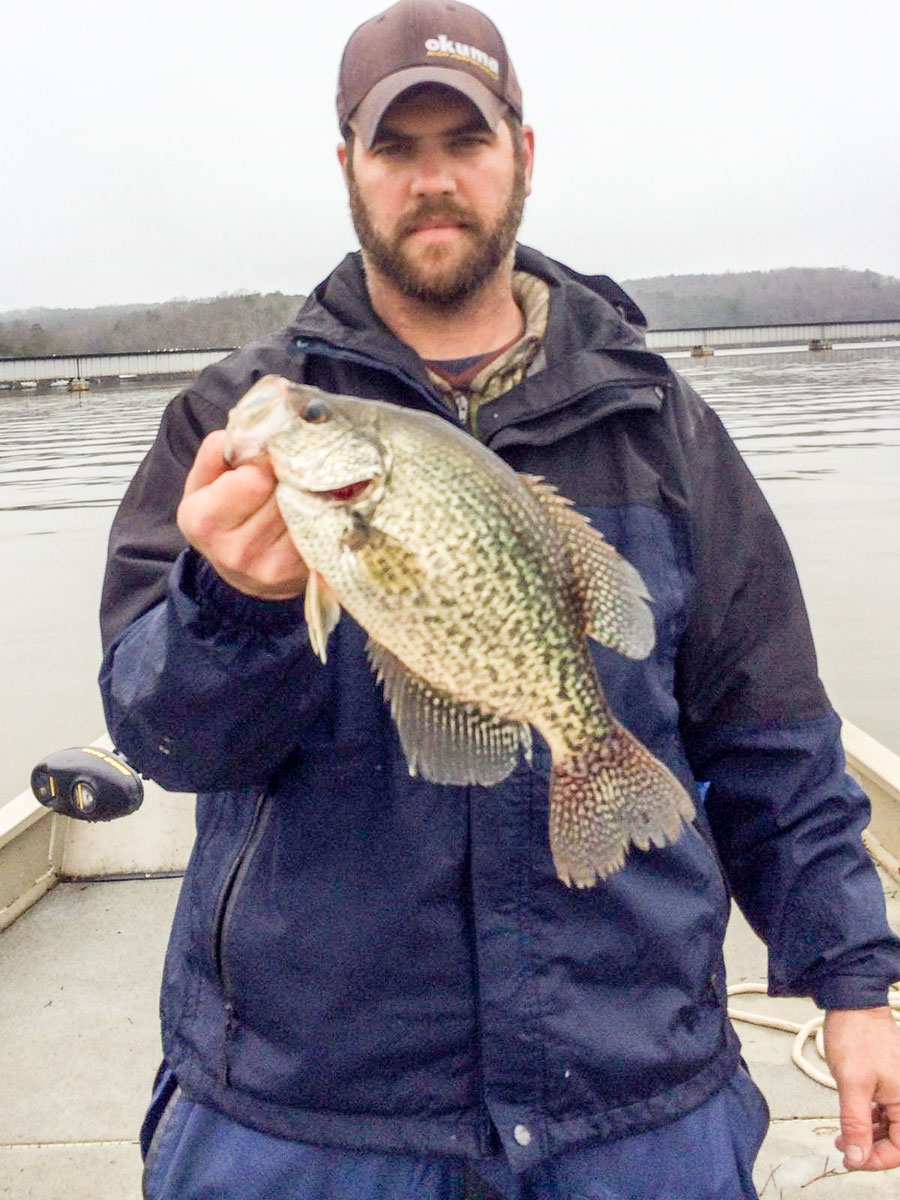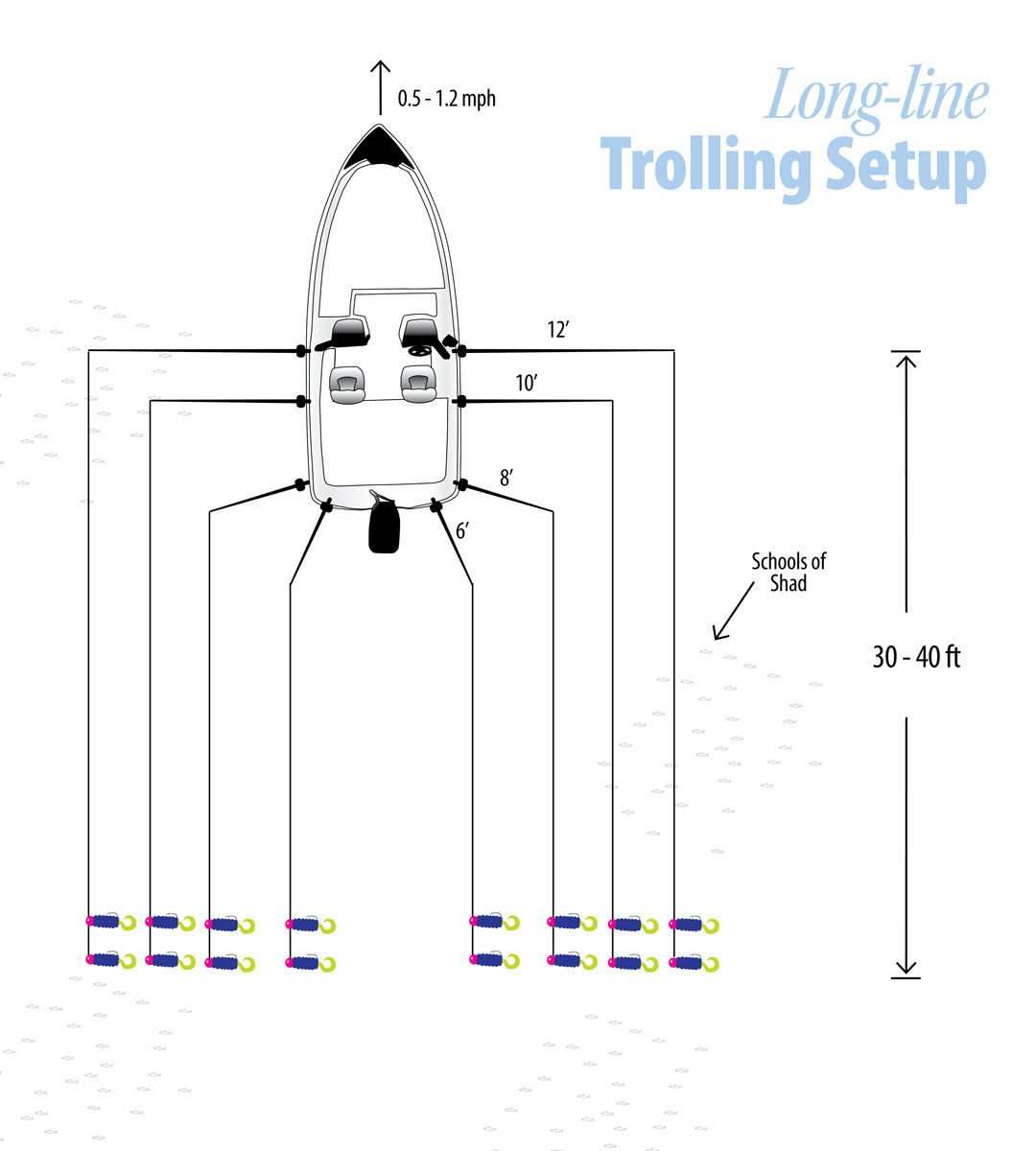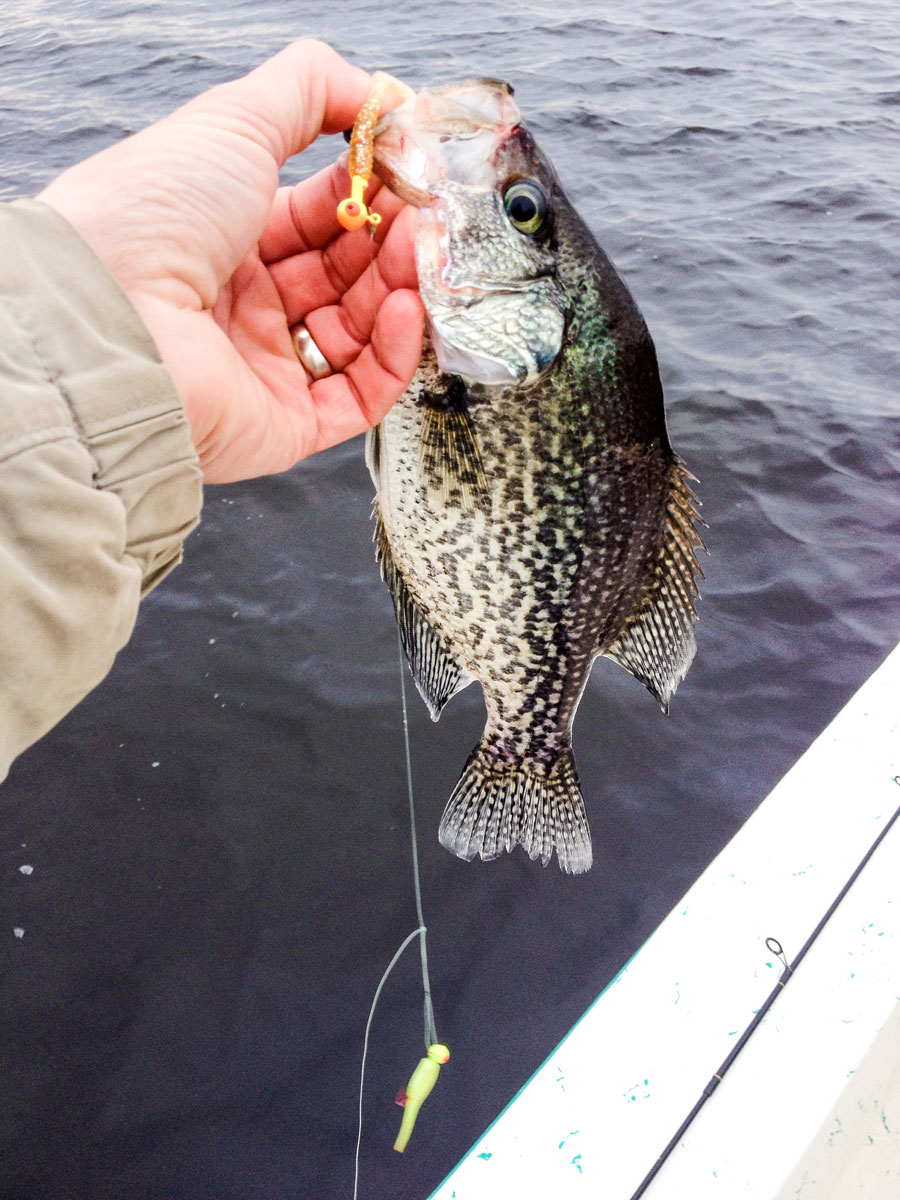
Long-line trolling will put fish in the boat, according to two veteran guides.
To say that a January morning is brisk can be an understatement, but with any luck, the frost will give way to sunshine and biting fish. At Badin Lake on the Yadkin River chain, hungry and healthy crappie will most likely be holding tight to baitfish schools, hovering over deep-water creeks and coves, where long-line trolling a dragnet of jigs is the most efficient way to fill your 20-fish limit.
Crappie are generally sticklers for cover and structure, using brush and ledges as ambush points to fill their stomachs. However, when shad vacate the creeks and relatively shallow waters as temperatures plummet, crappie are forced to become nomadic and shadow the forage.
According to guide Chris Hammill of Kannapolis, finding crappie in these areas is a numbers game.
“Open-water fishing is more determined by water temperature than time of year, and it correlates with the shad moving out of the creeks,” said Hammill, who runs Hammill Outdoor Adventures. “Water temperatures from the low 50s to mid 40s will usually have crappie suspended in open water at Badin. It peaks from 48 to 44 degrees.”
It’s the drop in water temperature that opens the window of opportunity for long-line trolling in winter.
“From 60 degrees to the low 50s, they’ll gang up on deep brush, where it’s best to vertical jig with jigs and minnows. From the low 40s down, they’ll start dropping too deep to long-line and you can catch them better by moving slower and tight-lining.”

What makes this window unique is that crappie are suspended high in the water column, and they are active, tying on the feed bag before being forced to the bottom.
“When I’m long-lining, I’m generally targeting fish within 20 feet of the surface,” Hammill said. “Ninety percent of the fish I catch are 8 to 12 feet down, around the schools of shad.”
Hammill’s long-line trolling spread consists of 6 to 8 rods, set from the gunwales of his boat to the stern. Two 6- to 7-foot rods point straight back from the transom, and the others line the sides, increasing in length to 12 feet to keep the jigs separated. Each rod is outfitted with a tandem arrangement of jigs, often on 1/16-ounce jigheads.
“I generally tie one jig to the end of the line with a Palomar or improved clinch knot, then I’ll tie a loop knot about 20 inches up above that,” he said. “I’ll pinch the loop in the loop knot and push it through the eye of the jig and then loop the jig through it. That way, it’s hanging down from the main line.”
One of the biggest advantages of long-line trolling over tightlining is boat speed. With baits behind the boat, a long-liner can nearly double the speed and the area covered by a tightliner, whose baits are perched from the bow.
“Usually the ideal speed is 0.7 to 1 mph,” said Hammill, “but I’ve caught them from 0.5 to 1.2 mph. Speed is not as much an issue as getting the bait at the right depth.
“It’s a sight-feeding presentation. You’re targeting visually feeding fish. If you’re over 60 feet of water and the fish are 10 to 15 feet down, those are the biters. If you get a jig in front of their faces, they’re going to eat it.”
Hammill will usually change his boat speed to raise or lower his rigs so they’re 2 to 3 feet above the crappie, but he will also mix and match jigheads to add a variety of depths. Double 1/16-, a 1/16- and a 1/8-, or double 1/8-ounce jigs are his normal combinations. Using heavier jigheads allows Hammill to troll baits closer to the boat, in the 30- to 40-foot range, as opposed to micro jigs, which require at least double these lengths.
Guide Maynard Edwards of Lexington shares the same ideas as Hammill.
“Long-lining is the best technique when crappie are not on the bottom,” said Edwards, who runs Yadkin Lakes Guide Service.
While both guides’ strategies are largely the same, Edwards will use a Roadrunner on the terminal end of his rig instead of a standard jig to add an element of flash and vibration to the presentation.
 Edwards favors 10-pound Fireline on his spinning reels before attaching his leaders.
Edwards favors 10-pound Fireline on his spinning reels before attaching his leaders.
“All of my leaders are premade of 8- to 10-pound monofilament,” he said. “Lately, I’ve been using the Suffix Seige. It’s very flexible, and I can get it in camouflage, so it’s less visible in clear water.”
Color preferences for curlytail jigs vary between anglers, but the tried and true favorites are hard to beat.
“John Deere green or a greenish color is awesome, I don’t care where you go,” said Edwards. “A lot of the jigs we use are black with a blue tip or black with a chartreuse tip. Popsicle is also a good color.
“But Badin is mostly a clear-water lake; sometimes the bright colors work,” said Edwards. “I’ll tie on bright and dark colors on my rigs and then switch over to what’s working best.”
Hammill echoed the proficiency of bright colors in clear water and touts acid rain as one of his favorites.
“That’s a white body with a chartreuse tail. It’s hands down caught more fish for me at Badin. I always have it in the spread,” he said.
Hammill believes clear water is of the utmost importance for trolling.
“If I find bait in dirty water, I will leave there to look for bait in clear water before I force myself to troll in dirty water,” he said. “The Circle Drive side of the lake is good because it isn’t subject to the influx of water coming down the river, and there’s usually a lot of bait. It stays a lot clearer than the Old Whitney arm.”
When scouting, Hammill pays close attention to his side-imaging sonar, taking note of baitfish schools that he can troll through.
“These fish are not really structure related,” he said. “They’ll be in 25 to 60 feet of water, in areas that hold a lot of bait. If there are schools of shad, they’ll be crappie in there with them. The Lake Forest area, Glady’s Fork, and Skier’s Cove are all long-lining hot spots on the Circle Drive side of the lake.”
“A sunny, protected creek can have suspended fish in January,” said Edwards. “They’ll be in the main parts of the creek, right slap in the middle, not near a lot of cover. Go in about 300 yards until you start marking fish, and then turn around and troll through them. You can also find them in the bigger necks that don’t have names.”

Rounding out at about 5,350 acres, Badin Lake isn’t one of North Carolina’s most-formidable bodies of water, and it isn’t necessarily known for churning out huge numbers of crappie. But, what it lacks in quantity, it more than makes up for in quality.
“You’re not going to catch 100, like at High Rock. A good day at Badin would be around 40 fish,” Edwards said. “But the fish at High Rock are small. At Badin, the average fish is in the 11- to 14-inch range. Once in a while, you’ll get one that’s 15 inches. It’s a good healthy lake size-wise.”
Edwards warns not to underestimate the size or become too confident.
“You better bring a net to Badin in the colder months; trying to lift one of these fish into the boat is a good way to break a rod or your line.”
DESTINATION INFORMATION
HOW TO GET THERE — Badin Lake is slightly more than 20 miles southwest of Asheboro and 10 miles northeast of Albemarle. NC 109 and US 2 run nearly parallel north to south on either side of the lake. Popular public boat ramps are at the town of Badin on the west side of the lake at the dam and Circle Drive off NC8 and NC 49 on the northeast side of the lake. Visit www.ncwildlife.org for more options.
WHEN TO GO — Badin Lake’s crappie can be caught year-round. Long-line trolling techniques are best from late December through January, but tactics are subject to change based on water tempeature.
BEST TECHNIQUES — Long-line trolling is a great cold-weather tactic, using a spread of 6 to 8 rods set up in staggered lengths to keep the baits from being tangled. Cast 30 to 40 feet behind the boat, tandem jig rigs can be adjusted in depth by varying an average speed of 0.7 mph. Jighead weights range from 1/16- to 1/8-ounce. Curlytail grubs are best mixed with light and dark colors to discover the day’s preference. Areas of interest are deep, clear coves and creeks with a wealth of baitfish schools to troll through.
FISHING INFO/GUIDES — Chris Hammill, Hammill Outdoor Adventures, 704-239-7921, www.hammillsfishing.webs.com; Maynard Edwards, Yadkin Lakes Guide Service, 336-247-1287; Highway 49 Sporting Goods, New London, 704-463-7053. See also Guides and Charters in Classifieds.
ACCOMMODATIONS — Stanly County Chamber of Commerce, 704-982-8116; The Badin Inn and Golf Club, Badin, 704-422-3683, www.badininn.com; Pineview Inn, New London, 704-463-7862.
MAPS — Yadkin Inc., www.alcoa.com/yadkin/en/pdf/narrowsrecareas.pdf.





Be the first to comment